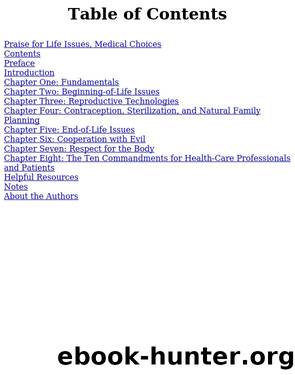Life Issues, Medical Choices by Janet E. Smith

Author:Janet E. Smith
Language: eng
Format: epub
ISBN: 9781616369385
Publisher: Franciscan Media
Published: 2016-03-09T00:00:00+00:00
Chapter Five: End-of-Life Issues
Question 38: What is euthanasia?
The term euthanasia literally means âgood death,â but it has largely come to mean âmercy killing.â Mercy here refers to alleviating suffering. The thought is that it would be merciful to kill those who would prefer to die rather than endure a state of physical or mental incapacity.
The call to legalize euthanasia is a call to legalize practices that intentionally kill innocent human beings. The Congregation for the Doctrine of the Faith has stated: âBy euthanasia is understood an action or an omission which of itself or by intention causes death, in order that all suffering may in this way be eliminated. Euthanasiaâs terms of reference, therefore, are to be found in the intention of the will and in the methods used.â70
Direct euthanasia refers to killing a patient intentionally as a means or as an end. Direct euthanasia can be done by either commission or omission. In euthanasia by commission, or active euthanasia, someone takes an active measure, such as lethal injection, to kill a patient. In euthanasia by omission, or passive euthanasia, someone responsible for providing care omits morally obligatory treatment in order to kill the patient. (In Question 40 we will explain when it is morally permissible to withhold or stop treatment and simply let the dying process take over.) The Church reserves the term euthanasia for intentional killing, whether by commission or omission; thus, it teaches that both active and passive euthanasia are morally wrong.
Voluntary euthanasia refers to a situation in which a patient asks to be killed; nonvoluntary euthanasia refers to a situation in which a patient has not indicated whether or not he or she desires to be killed; and involuntary euthanasia refers to a situation in which a patient is killed against his or her will.
Almost everyone agrees that killing an innocent person against that personâs will is wrong, whether one does it by directly killing the person or by allowing a person to die when one could save that person with a reasonable amount of effort. For instance, there is no moral difference between directly drowning someone (say, holding his or her head underwater) and standing by and letting someone drown when one easily could rescue the person. Neither is there a moral difference between giving someone a lethal injection and refusing reasonable care, such as not putting a tourniquet on someone who is bleeding profusely in order to kill him.
It is difficult in our culture to explain why it is not morally permissible to kill someone who wants to die, unless one understands the true value of human life and our responsibilities to each patient no matter how ill (see Questions 38 and 41). It is also difficult sometimes to determine the difference between the morally impermissible act of passive euthanasia, which involves withholding morally obligatory treatment with the intention that someone die, and the morally permissible act of withholding optional treatment even though death is foreseen. We shall address this issue in the section on ordinary and extraordinary means (Question 43).
Download
This site does not store any files on its server. We only index and link to content provided by other sites. Please contact the content providers to delete copyright contents if any and email us, we'll remove relevant links or contents immediately.
Signature in the Cell: DNA and the Evidence for Intelligent Design by Stephen C. Meyer(3055)
Real Sex by Lauren F. Winner(2950)
The Secret Power of Speaking God's Word by Joyce Meyer(2925)
The Holy Spirit by Billy Graham(2880)
The Gnostic Gospels by Pagels Elaine(2459)
Jesus by Paul Johnson(2294)
Devil, The by Almond Philip C(2266)
23:27 by H. L. Roberts(2186)
The Nativity by Geza Vermes(2165)
Chosen by God by R. C. Sproul(2113)
All Things New by John Eldredge(2092)
Angels of God: The Bible, the Church and the Heavenly Hosts by Mike Aquilina(1916)
The Return of the Gods by Erich von Daniken(1886)
Angels by Billy Graham(1876)
Knowing God by J.I. Packer(1793)
Jesus of Nazareth by Joseph Ratzinger(1754)
Evidence of the Afterlife by Jeffrey Long(1734)
The Gnostic Gospel of St. Thomas by Tau Malachi(1726)
How To Be Born Again by Billy Graham(1718)
